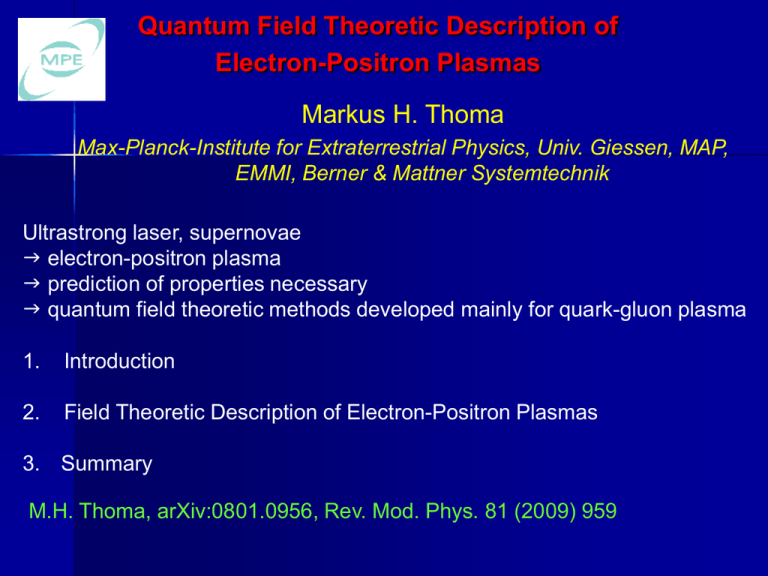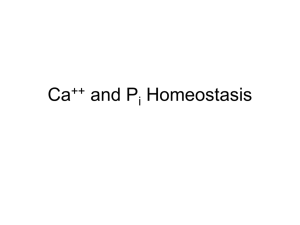PowerPoint-Präsentation - Physikalisches Institut Heidelberg
advertisement

Quantum Field Theoretic Description of Electron-Positron Plasmas Markus H. Thoma Max-Planck-Institute for Extraterrestrial Physics, Univ. Giessen, MAP, EMMI, Berner & Mattner Systemtechnik Ultrastrong laser, supernovae g electron-positron plasma g prediction of properties necessary g quantum field theoretic methods developed mainly for quark-gluon plasma 1. Introduction 2. Field Theoretic Description of Electron-Positron Plasmas 3. Summary M.H. Thoma, arXiv:0801.0956, Rev. Mod. Phys. 81 (2009) 959 1. Introduction What is a plasma? Plasma = (partly) ionized gas (4. state of matter) 99% of the visible matter in universe Plasmas emit light Plasmas can be produced by high temperatures electric fields kT mc2 Relativistic plasmas: Quantum plasmas: B Strongly coupled plasmas: h d m v th Q2 GC 1 d kT radiation (Supernovae) (White Dwarfs) (WDM, Dusty Plasmas, QGP) GC: Coulomb coupling parameter = Coulomb energy / thermal energy W. dwarfs Supernova Quantum Plasmas bar 106 Pressure 103 Relativistic Plasmas Complex Plasmas Sun Strongly coupled Plasmas Flames 1 Lightening “Neon” Tubes Fusion 10-3 Discharges 10-6 Aurora Corona Comets 100 103 Temperature 106 Kelvin What is an electron-positron plasma? Strong electric or magnetic fields, high temperatures g massive pair production (E > 2mec2 = 1.022 MeV) g electron-positron plasma Astrophysical examples: • Supernovae: Tmax = 3 x 1011 K g kT = 30 MeV >> 2mec2 • Magnetars: Neutron Stars with strong magnetic fields B > 1014 G • Accretion disks around Black Holes High-intensity lasers (I > 1024 W/cm2) ELI: The Extreme Light Infrastructure European Project Recent developments in laser technology gultrashort pulses (10-18 s), ultrahigh intensities (> 1023 W/cm2) g observation of ultra-fast processes (molecules), particle acceleration, ultradense matter, electron-positron plasma Possibilities for electron-positron plasma formation: Habs et al. • Thin gold foil (~1 mm) hit by two laser pulses from opposite sides (B. Shen, J. Meyer-ter-Vehn, Phys. Rev. E 65 (2001) 016405) g target electrons heated up to multiMeV temperatures g e- - e+ plasma • Colliding laser pulses g pair creation at about 1/100 of critical field strength, i.e. 1014 V/cm corresponding to 5 x 1025 W/cm2 (ELI, XFEL) g electromagnetic cascade, depletion of laser energy (A.M. Fedotov et al., PRL 105 (2010) 080402) • Laser-electron beam interaction (ELI-NP: two 10 PW lasers plus 600 MeV electron beam) (D. Habs, private communication) 2. Field Theoretic description of Electron-Positron Plasmas Here: Properties of a thermalized electron-positron plasma, not production and equlibration • Equation of state Assumptions: • ultrarelativistic gas: T >> me (h = c = k =1) • thermal and chemical equilibrium • electron density = positron density g zero chemical potential • ideal gas (no interactions) • infinitely extended, homogeneous and isotropic Electron and positron distribution function: 1 n B Photon distribution function: eE / T 1 nF 1 eE / T 1 Ultrarelativistic particles: E = p Particle number density: eq e d3p 3 gF n ( p) 0 . 37 T , gF 4 F 3 ( 2 ) 3 370 MeV Example: T = 10 MeV g eq e Conversion: 1 c 1.97 1013 MeV m 1MeV 1.60 1013 J 5.08 1012 m1 1.52 1021s 1 40 3 eq e 4.9 10 m Photon density: Photons in equilibrium with electrons and positrons g electron-positron-photon gas eq d3p 3 gB n ( p) 0 . 24 T , gB 2 B 3 ( 2 ) Energy density: Stefan-Boltzmann law eq d3p d 3p 4 gF p n ( p) g p n ( p) 1 . 81 T F B B ( 2 )3 ( 2 )3 T = 10 MeV: eq 3.8 1029 J m3 Photons contribute 36% to energy density Volume of neutron star (10 km diameter) g E ~ 1041 J corresponding to about 10% of entire Supernova energy (without neutrinos) Volume 1 mm3 g E = 3.8 x 1011 J = 0.1 kto TNT Energy of a laser pulse about 100 J at I > 1024 W/cm2 ! Is the ideal gas approximation reliable? Coulomb coupling parameter: GC = e2/(dT) Interparticle distance: d ~ (eqe)-1/3 = 2.7 x 10-14 m at T = 10 MeV gGC = 5.3 x 10-3 g weakly coupled QED plasma g equation of state of an ideal gas is a good approximation; interactions can be treated by perturbation theory Quark-gluon plasma: GC = 1 – 5 g quark-gluon plasma liquid? • Collective phenomena Interactions between electrons and positrons g collective phenomena, e.g. Debye screening, plasma waves, transport properties, e.g. viscosity Non-relativistic plasmas (ion-electron): Classical transport theory with scales: T, me g Debye screening length Plasma frequency pl D kT 4 e 2 e 4 e 2 e me Ultrarelativistic plasmas: scales T (hard momenta), eT (soft momenta) Collective phenomena: soft momenta Transport properties: hard momenta Relativistic interactions between electrons g QED Perturbation theory: Expansion in a = e2/4 =1/137 (e = 0.3) using Feynman diagrams, e.g. electron-electron scattering Evaluation of diagrams by Feynman rules g scattering cross sections, damping and production rates, life times etc. Interactions within plasma: QED at finite temperature Extension of Feynman rules to finite temperature (imaginary or real time formalism), calculations more complicated than at T=0 Application: quark-gluon plasma (thermal QCD) Example: Photon self-energy or polarization tensor (K=(,k)) Isotropic medium g 2 independent components depending on frequency and momentum k=|k| High-temperature or hard thermal loop limit (T >> , k ~ eT): k L 3m2 1 ln , 2k k 3 2 2 T m 2 2 k k2 k ln 1 1 2 2 k k Effective photon mass: m eT 3 T 10 MeV m 1MeV Dielectric tensor: Momentum space: Di ( ,k ) ij ( ,k )E j ( ,k ) Isotropic medium: ki k j ij ( ,k ) T ( ,k ) ij 2 k i, j x,y,z ki k j L ( ,k ) 2 k Relation to polarization tensor: 3m L ( ,k ) L ( ,k ) 1 1 2 2 k k k 1 ln 2k k 3m T ( ,k ) T ( ,k ) 1 1 2 2k 2 k2 k ln 1 1 2 2 k k 2 2 Alternative derivation using transport theory (Vlasov + Maxwell equations) Same result for quark-gluon plasma (apart from color factors) k2 Maxwell equations g L ( ,k ) 0, T ( ,k ) 2 g propagation of collective plasma modes g dispersion relations Plasma frequency: pl L,T ( k 0 ) m 1.5 1021 Hz (T 10 MeV ) Plasmon pl Landau damping 2 k 2 Im L,T 0 Yukawa potential: e r D V( r ) r with Debye screening length D 1 3 m 1.1 10 13 m (T 10 MeV ) Relativistic plasmas g Fermionic plasma modes: dispersion relation of electrons and positrons in plasma Electron self-energy: gelectron dispersion relation (pole of effective electron propagator containing electron self-energy) g Plasmino branch Note: minimum in plasmino dispersion gvan Hove singularity g unique opportunity to detect fermionic modes in laser produced plasmas • Transport properties Transport properties of particles with hard (thermal) momenta (p ~ T) using perturbative QED at finite temperature p~T For example electron-electron scattering g electron damping (interaction) rate, electon energy loss, shear viscosity k Problem: IR divergence gHTL perturbation theory (Braaten, Pisarski, Nucl. Phys. B337 (1990) 569) Resummed photon propagator for soft photon momenta, i.e. k ~ eT 1 D 2 , L e2T 2 k L * L g IR improved (Debye screening), gauge independent results complete to leading order • Electron damping rates and energy loss e2T 1 e v ln 4 e • Transport coefficients of e--e+ plasma, e.g. shear viscosity T3 4 e ln(1 e) • Photon damping ph e4T 2 E ln 2 64 E e T Mean free path 1/ph = 0.3 nm for T=10 MeV for a thermal photon • Photon Production Thermal distribution of electrons and positrons, expansion of plasma droplet (hydrodynamical model) g Gamma ray flash from plasma droplet shows continuous spectrum (not only 511 keV line) M.G. Mustafa, B. Kämpfer, Phys. Rev. A 79 (2009) 020103 EoS Collective Transport • Chemical non-equilibrium 40 3 T= 10 MeV g equilibrium electron-positron number density eq 10 m Experiment: colliding laser pulses g electromagn. cascade, laser depletion gmax. electron-positron number about 1013 in a volume of about 0.1 mm3 (diffractive limit of laser focus) at I = 2.7 x 1026 W/cm2 32 3 g exp 10 m 2 (A.M. Fedotov et al., PRL 105 (2010) 080402) exp< eq g non-equilibrium plasma Assumption: thermal equilibrium but no chemical equilibrium g electron distribution function fF = nF with fugacity 1 exp d 3p 8 gF n ( p) 10 F eq ( 2 )3 Non-equilibrium QED: 2 4 e m2 dp p fF ( p ) 2 3 0 M.E. Carrington, H. Defu, M.H. Thoma, Eur. Phys. C7 (1999) 347 m meq 100 eV pl 1.5 1017 Hz Electron plasma frequency in sun (center): pl 5 10 Hz 17 Debye screening length: D 1nm Collective effects important since extension of plasma L ~ 1 mm >> D Electron density > positron density g finite chemical potential m • Particle production Temperature high enough g new particles are produced Example: Muon production via Equilibrium production rate: 2 2 1 e ( E p ) 2T dN a 2 2mm 4mm T 1 1 2 1 2 ln 4 4 4 ET d xd p 36 M M p e 1 1 e ( E p ) 2T Invariant photon mass: M 2 E2 p2 4mm2 Muon production exponentially suppressed at low temperatures T < mm= 106 MeV Very high temperatures (T > 100 MeV): Hadronproduction (pions etc.) and Quark-Gluon Plasma I. Kuznetsova, D. Habs, J. Rafelski, Phys. Rev. D 78 (2008) 014027 3. Summary • Aim: prediction of properties of ultrarelativistic electron-positron plasmas produced in laser fields and supernovae • Ultrarelativistic electron-positron plasma: weakly coupled system g ideal gas equation of state (in contrast to QGP) • Interactions in plasma g perturbative QED at finite temperature g collective phenomena (plasma waves, Debye screening) and transport properties (damping rates, mean free paths, relaxation times, production rates, viscosity, energy loss) using HTL resummation • New phenomenon: Fermionic collective plasma modes (plasmino), van Hove singularities? • Deviation from chemical equilibrium g perturbative QED in non-equilibrium






